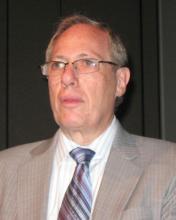User login
HONOLULU – Oral therapies for relapsing-remitting multiple sclerosis that are in the development pipeline have neurologists feeling both excited and a bit apprehensive.
"There are a whole slew of orals coming," Dr. Mariko Kita said in an interview at the annual meeting of the American Academy of Neurology. "It’s really exciting, but I think it will be challenging for the clinician" because there will be inadequate guidance on which drug or drugs to prioritize in treatment, how best to combine various therapies, and other clinical questions.
"I think it’s going to be very intimidating, actually," said Dr. Kita, director of the Multiple Sclerosis Center at Virginia Mason Medical Center, Seattle.
She comoderated a session at the meeting on multiple sclerosis trials that included a report on a pooled analysis of safety data on the only approved oral therapy for multiple sclerosis, fingolimod (Gilenya). The session also included positive phase III clinical trial results for the experimental oral therapy teriflunomide. Earlier in the meeting, separate investigators reported positive phase III clinical trial results for the experimental oral therapy laquinimod.
Another oral agent under study, BG-12 (dimethyl fumarate), received Fast Track designation from the Food and Drug Administration and is in phase III clinical trials. Cladribine (Leustatin), which is currently marketed as chemotherapy for certain leukemias and lymphomas, initially was rejected by the FDA when it was submitted for approval as an oral therapy for multiple sclerosis. Following resubmission by the manufacturer, the FDA in early 2011 sent a letter to the company acknowledging sufficient data on the drug’s efficacy in multiple sclerosis but requiring more data on safety and risk-benefit considerations before it could be approved.
Dr. Kita’s comoderator, Dr. Benjamin N. Greenberg, commented after the session that with the expected approvals of several oral agents for multiple sclerosis over the next few years, "I’m getting concerned that there’s going to be a little bit of a free-for-all coming." But he added, "It’s good to have options. We’re all thrilled."
The only head-to-head comparison of an oral therapy against another active treatment for multiple sclerosis so far is a study of fingolimod vs. interferon, he noted. Direct comparisons of the various oral agents will be needed to help clinicians develop treatment strategies, said Dr. Greenberg, a neurologist at the University of Texas Southwestern Medical Center, Dallas.
Gilenya may have some superior efficacy, compared with once-weekly interferon dosing, Dr. Kita said, but its potential adverse cardiovascular effects and "downstream consequences in terms of effects on different organ systems makes another oral daily alternative with less toxicity that much more appealing."
Dr. Aaron Miller of Mount Sinai School of Medicine, New York, and Dr. Jerry S. Wolinsky of the University of Texas Health Science Center, Houston, presented results of the Teriflunomide Multiple Sclerosis Oral (TEMSO) trial during the session. The multinational, double-blind study randomized 1,088 patients with relapsing-remitting multiple sclerosis to a single daily dose of 7 mg or 14 mg of teriflunomide or placebo for 2 years.
Results of the TEMSO trial were first reported in late 2010.
Both doses reduced the annualized relapse rate by approximately 31%, compared with placebo. The annualized relapse rate was 0.37 in each of the treatment groups and 0.54 in the placebo group. The risk of disability progression also was significantly reduced by 30% in the 14-mg group but was not significantly different in the 7-mg group, compared with placebo.
Both doses showed significant improvements, compared with placebo, in brain disease activity on various MRI tests, although some MRI measures of disease activity were significantly better only in the high-dose group, compared with placebo.
Results of the 2-year, randomized, double-blind study of laquinimod that was presented earlier at the meeting showed an annual relapse rate of 0.304 on laquinimod, a 23% reduction compared with a rate of 0.395 on placebo. The laquinimod group also showed 33% less brain atrophy and significant improvements in brain disease activity on various MRI measures.
Both teriflunomide and laquinimod appeared to be relatively well tolerated. But among 11 women who became pregnant in the TEMSO study, 3 of 4 spontaneous abortions occurred in the teriflunomide groups. Six of the other pregnant women underwent induced abortions, and one woman successfully delivered a healthy baby.
"I thought that the teriflunomide study was interesting. It was impressive to see that a fairly low dose like that, which seems to be very well tolerated, could have effects on both the MRI and on the clinical end points," Dr. Kita said. "My concern for it is making sure that we understand what the impact is on the female population, on the childbearing years. We know that its parent compound can have teratogenic effects, and I’m not sure we know yet how safe teriflunomide will be in the population."
Dr. Kita said she has no relevant conflicts of interest. Dr. Greenberg disclosed financial relationships with DioGenix, Biogen Idec (which is developing BG-12), EMD Serono (which is developing cladribine), Teva Neurosciences (which is developing laquinimod), and the Greater Good Foundation.
Sanofi-Aventis, which is developing teriflunomide, funded the TEMSO trial. Dr. Miller, Dr. Wolinsky, and many of their associates in the study disclosed relationships with Sanofi-Aventis and with numerous other companies that make therapies for multiple sclerosis. Three of their co-investigators were employees of Sanofi-Aventis.
HONOLULU – Oral therapies for relapsing-remitting multiple sclerosis that are in the development pipeline have neurologists feeling both excited and a bit apprehensive.
"There are a whole slew of orals coming," Dr. Mariko Kita said in an interview at the annual meeting of the American Academy of Neurology. "It’s really exciting, but I think it will be challenging for the clinician" because there will be inadequate guidance on which drug or drugs to prioritize in treatment, how best to combine various therapies, and other clinical questions.
"I think it’s going to be very intimidating, actually," said Dr. Kita, director of the Multiple Sclerosis Center at Virginia Mason Medical Center, Seattle.
She comoderated a session at the meeting on multiple sclerosis trials that included a report on a pooled analysis of safety data on the only approved oral therapy for multiple sclerosis, fingolimod (Gilenya). The session also included positive phase III clinical trial results for the experimental oral therapy teriflunomide. Earlier in the meeting, separate investigators reported positive phase III clinical trial results for the experimental oral therapy laquinimod.
Another oral agent under study, BG-12 (dimethyl fumarate), received Fast Track designation from the Food and Drug Administration and is in phase III clinical trials. Cladribine (Leustatin), which is currently marketed as chemotherapy for certain leukemias and lymphomas, initially was rejected by the FDA when it was submitted for approval as an oral therapy for multiple sclerosis. Following resubmission by the manufacturer, the FDA in early 2011 sent a letter to the company acknowledging sufficient data on the drug’s efficacy in multiple sclerosis but requiring more data on safety and risk-benefit considerations before it could be approved.
Dr. Kita’s comoderator, Dr. Benjamin N. Greenberg, commented after the session that with the expected approvals of several oral agents for multiple sclerosis over the next few years, "I’m getting concerned that there’s going to be a little bit of a free-for-all coming." But he added, "It’s good to have options. We’re all thrilled."
The only head-to-head comparison of an oral therapy against another active treatment for multiple sclerosis so far is a study of fingolimod vs. interferon, he noted. Direct comparisons of the various oral agents will be needed to help clinicians develop treatment strategies, said Dr. Greenberg, a neurologist at the University of Texas Southwestern Medical Center, Dallas.
Gilenya may have some superior efficacy, compared with once-weekly interferon dosing, Dr. Kita said, but its potential adverse cardiovascular effects and "downstream consequences in terms of effects on different organ systems makes another oral daily alternative with less toxicity that much more appealing."
Dr. Aaron Miller of Mount Sinai School of Medicine, New York, and Dr. Jerry S. Wolinsky of the University of Texas Health Science Center, Houston, presented results of the Teriflunomide Multiple Sclerosis Oral (TEMSO) trial during the session. The multinational, double-blind study randomized 1,088 patients with relapsing-remitting multiple sclerosis to a single daily dose of 7 mg or 14 mg of teriflunomide or placebo for 2 years.
Results of the TEMSO trial were first reported in late 2010.
Both doses reduced the annualized relapse rate by approximately 31%, compared with placebo. The annualized relapse rate was 0.37 in each of the treatment groups and 0.54 in the placebo group. The risk of disability progression also was significantly reduced by 30% in the 14-mg group but was not significantly different in the 7-mg group, compared with placebo.
Both doses showed significant improvements, compared with placebo, in brain disease activity on various MRI tests, although some MRI measures of disease activity were significantly better only in the high-dose group, compared with placebo.
Results of the 2-year, randomized, double-blind study of laquinimod that was presented earlier at the meeting showed an annual relapse rate of 0.304 on laquinimod, a 23% reduction compared with a rate of 0.395 on placebo. The laquinimod group also showed 33% less brain atrophy and significant improvements in brain disease activity on various MRI measures.
Both teriflunomide and laquinimod appeared to be relatively well tolerated. But among 11 women who became pregnant in the TEMSO study, 3 of 4 spontaneous abortions occurred in the teriflunomide groups. Six of the other pregnant women underwent induced abortions, and one woman successfully delivered a healthy baby.
"I thought that the teriflunomide study was interesting. It was impressive to see that a fairly low dose like that, which seems to be very well tolerated, could have effects on both the MRI and on the clinical end points," Dr. Kita said. "My concern for it is making sure that we understand what the impact is on the female population, on the childbearing years. We know that its parent compound can have teratogenic effects, and I’m not sure we know yet how safe teriflunomide will be in the population."
Dr. Kita said she has no relevant conflicts of interest. Dr. Greenberg disclosed financial relationships with DioGenix, Biogen Idec (which is developing BG-12), EMD Serono (which is developing cladribine), Teva Neurosciences (which is developing laquinimod), and the Greater Good Foundation.
Sanofi-Aventis, which is developing teriflunomide, funded the TEMSO trial. Dr. Miller, Dr. Wolinsky, and many of their associates in the study disclosed relationships with Sanofi-Aventis and with numerous other companies that make therapies for multiple sclerosis. Three of their co-investigators were employees of Sanofi-Aventis.
HONOLULU – Oral therapies for relapsing-remitting multiple sclerosis that are in the development pipeline have neurologists feeling both excited and a bit apprehensive.
"There are a whole slew of orals coming," Dr. Mariko Kita said in an interview at the annual meeting of the American Academy of Neurology. "It’s really exciting, but I think it will be challenging for the clinician" because there will be inadequate guidance on which drug or drugs to prioritize in treatment, how best to combine various therapies, and other clinical questions.
"I think it’s going to be very intimidating, actually," said Dr. Kita, director of the Multiple Sclerosis Center at Virginia Mason Medical Center, Seattle.
She comoderated a session at the meeting on multiple sclerosis trials that included a report on a pooled analysis of safety data on the only approved oral therapy for multiple sclerosis, fingolimod (Gilenya). The session also included positive phase III clinical trial results for the experimental oral therapy teriflunomide. Earlier in the meeting, separate investigators reported positive phase III clinical trial results for the experimental oral therapy laquinimod.
Another oral agent under study, BG-12 (dimethyl fumarate), received Fast Track designation from the Food and Drug Administration and is in phase III clinical trials. Cladribine (Leustatin), which is currently marketed as chemotherapy for certain leukemias and lymphomas, initially was rejected by the FDA when it was submitted for approval as an oral therapy for multiple sclerosis. Following resubmission by the manufacturer, the FDA in early 2011 sent a letter to the company acknowledging sufficient data on the drug’s efficacy in multiple sclerosis but requiring more data on safety and risk-benefit considerations before it could be approved.
Dr. Kita’s comoderator, Dr. Benjamin N. Greenberg, commented after the session that with the expected approvals of several oral agents for multiple sclerosis over the next few years, "I’m getting concerned that there’s going to be a little bit of a free-for-all coming." But he added, "It’s good to have options. We’re all thrilled."
The only head-to-head comparison of an oral therapy against another active treatment for multiple sclerosis so far is a study of fingolimod vs. interferon, he noted. Direct comparisons of the various oral agents will be needed to help clinicians develop treatment strategies, said Dr. Greenberg, a neurologist at the University of Texas Southwestern Medical Center, Dallas.
Gilenya may have some superior efficacy, compared with once-weekly interferon dosing, Dr. Kita said, but its potential adverse cardiovascular effects and "downstream consequences in terms of effects on different organ systems makes another oral daily alternative with less toxicity that much more appealing."
Dr. Aaron Miller of Mount Sinai School of Medicine, New York, and Dr. Jerry S. Wolinsky of the University of Texas Health Science Center, Houston, presented results of the Teriflunomide Multiple Sclerosis Oral (TEMSO) trial during the session. The multinational, double-blind study randomized 1,088 patients with relapsing-remitting multiple sclerosis to a single daily dose of 7 mg or 14 mg of teriflunomide or placebo for 2 years.
Results of the TEMSO trial were first reported in late 2010.
Both doses reduced the annualized relapse rate by approximately 31%, compared with placebo. The annualized relapse rate was 0.37 in each of the treatment groups and 0.54 in the placebo group. The risk of disability progression also was significantly reduced by 30% in the 14-mg group but was not significantly different in the 7-mg group, compared with placebo.
Both doses showed significant improvements, compared with placebo, in brain disease activity on various MRI tests, although some MRI measures of disease activity were significantly better only in the high-dose group, compared with placebo.
Results of the 2-year, randomized, double-blind study of laquinimod that was presented earlier at the meeting showed an annual relapse rate of 0.304 on laquinimod, a 23% reduction compared with a rate of 0.395 on placebo. The laquinimod group also showed 33% less brain atrophy and significant improvements in brain disease activity on various MRI measures.
Both teriflunomide and laquinimod appeared to be relatively well tolerated. But among 11 women who became pregnant in the TEMSO study, 3 of 4 spontaneous abortions occurred in the teriflunomide groups. Six of the other pregnant women underwent induced abortions, and one woman successfully delivered a healthy baby.
"I thought that the teriflunomide study was interesting. It was impressive to see that a fairly low dose like that, which seems to be very well tolerated, could have effects on both the MRI and on the clinical end points," Dr. Kita said. "My concern for it is making sure that we understand what the impact is on the female population, on the childbearing years. We know that its parent compound can have teratogenic effects, and I’m not sure we know yet how safe teriflunomide will be in the population."
Dr. Kita said she has no relevant conflicts of interest. Dr. Greenberg disclosed financial relationships with DioGenix, Biogen Idec (which is developing BG-12), EMD Serono (which is developing cladribine), Teva Neurosciences (which is developing laquinimod), and the Greater Good Foundation.
Sanofi-Aventis, which is developing teriflunomide, funded the TEMSO trial. Dr. Miller, Dr. Wolinsky, and many of their associates in the study disclosed relationships with Sanofi-Aventis and with numerous other companies that make therapies for multiple sclerosis. Three of their co-investigators were employees of Sanofi-Aventis.
FROM THE ANNUAL MEETING OF THE AMERICAN ACADEMY OF NEUROLOGY


